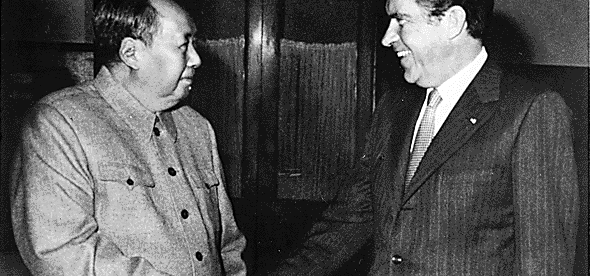The Red Menace

In World War II, China and the United States were ostensibly on the same side, united via their common enemies of Japan and Germany. But relations between the two quickly cooled after the war and for about twenty-five years, China and the U.S. had very little to do with one another. When Richard M. Nixon campaigned for President, he argued for changing that. And on February 21, 1972, Air Force One touched down in China, with Nixon about to begin a week-long tour of the nation featuring a historic meeting with Mao Zedong.
Given the gravity of the diplomatic mission, Nixon and team wanted to make sure that they were not caught off guard by anything out of the ordinary. On February 1st of that year, a delegation of approximately 100 Americans went to China as an “advance team” to map out as much as they possibly could — and often in extreme detail. For example, the Washingtonian notes that “the [advance team] worked out the best place for Nixon’s plane to land so that it would stop at the right distance and angle for good shots of his descent toward the reception party.”
Oh, and they discovered that their butts were turning red and itchy.
And yes, this was a major cause for concern. The President of the United States simply couldn’t fall prey to whatever had irritated the backsides of the advanced team; one cannot go on a critically important diplomatic trip and be scratching one’s tush between handshakes. So the advance team, despite the embarrassment involved, looked for a solution to what they called “baboon butt.” (If you don’t know why they gave it that name, here’s a gallery of images of baboon butts. And no, I can’t believe I typed that sentence either.)
The first step was to identify the cause. That turned out to be relatively easy — it was the shiny wooden toilet seats, something one doesn’t (and didn’t) often find in the United States. The toilet seats were finished with a varnish derived from a plant called “toxicodendron vernicifluum” or, more commonly (but tautologically) known as the Chinese lacquer tree. The sap from the tree contains an compound called urushiol which is also present in plants like poison sumac, poison ivy, and the like. Many American butts were allergic to the lacquer, causing the itchy red rash. Fun times.
The President’s butt needed to be protected, but the advance team was concerned that swapping out the toilet seats in their hotel (or other similarly obvious fix) would risk U.S./Chinese relations. Ultimately, the solution they came up with required a bit of reverse-espionage and a bit of fancy toilet paper. In the book “Freeing Tibet: 50 Years of Struggle, Resilience, and Hope,” authors John Roberts and Elizabeth Roberts explain:
The problem was how to politely convey this delicate matter to the Chinese government. After deliberating, they decided the most diplomatic way to raise the problem with their Chinese counterparts was to rely on the eavesdropping bugs they knew the Chinese had planted in their hotel room.
At exaggerated length, the advance men discussed their dilemma and ways to avoid irritating Nixon’s bottom. The next day, when they returned to their hotel room after the maid service, each toilet had a lace doily covering the seat. The Chinese had gotten the message. The way was now clear for a smooth Presidential visit.
Problem solved. Nixon’s visit went off without a hitch — and without an itch.
Bonus Fact: It wouldn’t have worked for the Chinese toilets, but if you have a lot of poison ivy around you and you want to get rid of it, you may want to rent a goat. That’s what the caretakers of Fort Hancock (a Spanish-American War-era military base in New Jersey) did in 2013 at the cost of about $12,000. Why? Goats like to eat poison ivy and aren’t affected by the urushiol. (As an added bonus, the allergen doesn’t pass through to the goats’ milk.)
From the Archives: Panda Diplomacy: Nixon’s trip yielded a gift of two panda — with strings attached.
Take the Quiz: Name the fourteen countries that border China.
Related: “Freeing Tibet: 50 Years of Struggle, Resilience, and Hope” by John Roberts and Elizabeth Roberts.
